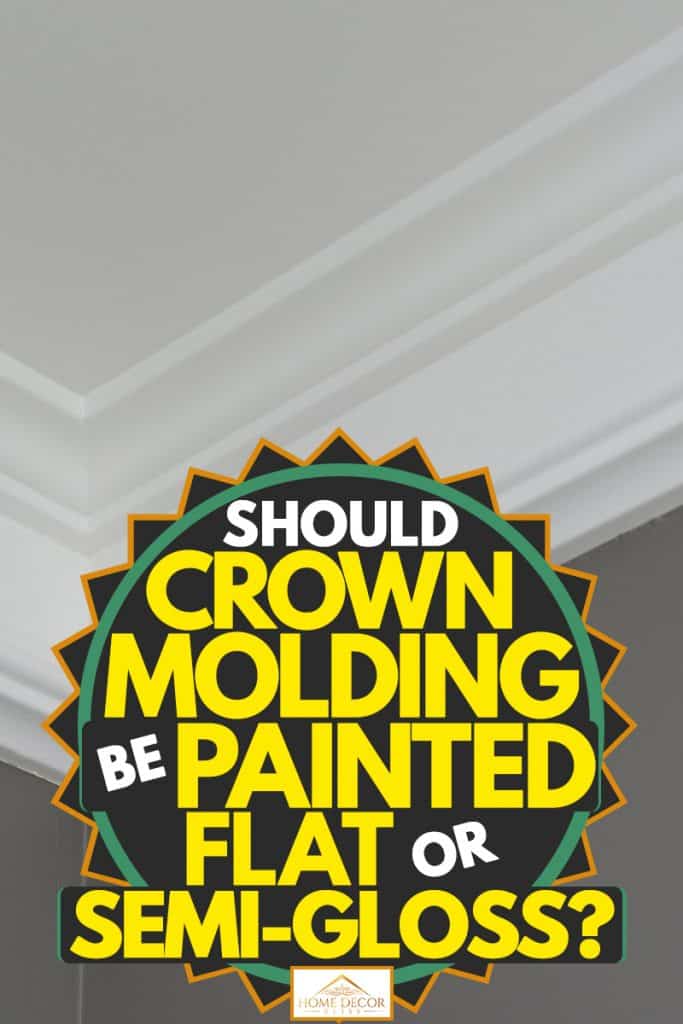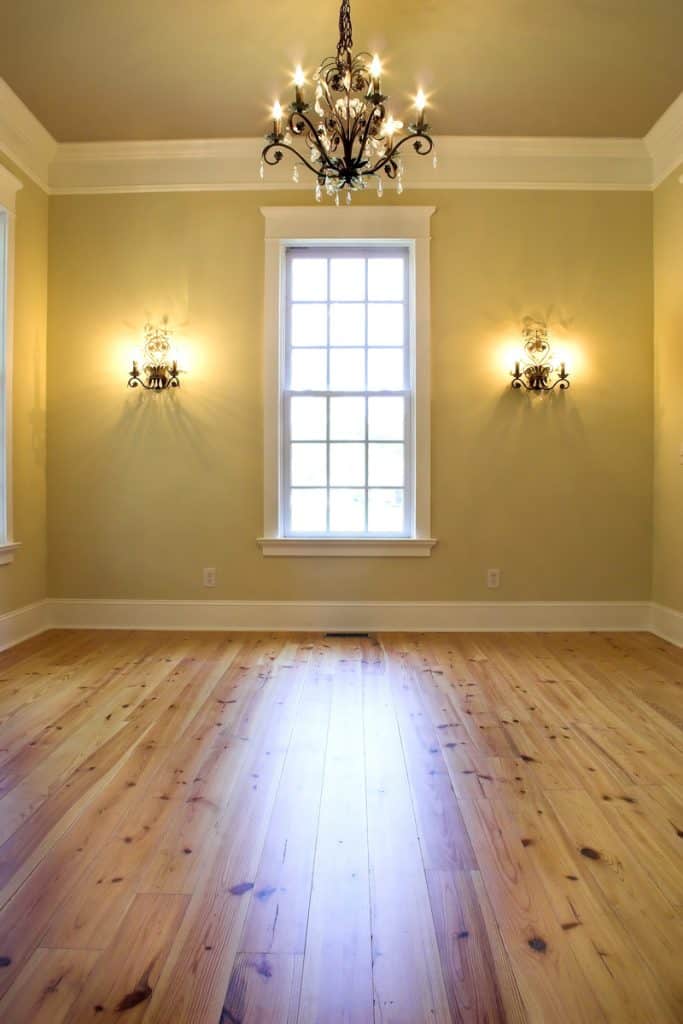Crown molding is a small feature with a big job to do. Wordlessly announcing the space where the wall ends and the ceiling begins is crown molding. Because of its role in tying the two elements together, molding should provide an eye-catching way to make the transition. So how should you paint your crown molding to give it the punch it needs?
Always paint crown molding with gloss paint, never flat. The walls and ceiling already use flat paint. Because of this, you want a finish that helps the crown distinguish itself, not blend in. A gloss (semi-gloss is typically preferred) gives it a bold and unique look to help it stand out as its own feature in the room.
Keep reading to learn more about the best way to use crown molding - more about the options for finish, what it should match, how to paint it, and more.

What Kind of Finish Should I Use?
There are three possible paint finishes for crown molding since you want to avoid a flat finish. They are:
- High gloss paints are the most durable and shiniest. This shiny gloss also reveals everyday wear and tear and makes any imperfections stand out.
- Semi-gloss conceals dings and marks better than high gloss. It isn't quite as shiny, but that also keeps flaws from being as noticeable. Unless you have experience as a painter (or pay one), you should err on the side of caution and select a semi-gloss.
- Satin finish paint has recently grown in popularity as a trendy choice (though still not frequently used as a glossy finish). It does not have the same lustrous sheen that glossy finishes do. It also is not as durable. In places where a more modern look or a rustic design is wanted, or when a glossy look may seem out of place, a satin finish can be a good choice.
Should Crown Molding and trim have the same finish?
Many people aren't exactly sure what they should match their crown molding with. It makes sense to coordinate with another feature of the room, to tie different elements neatly together for an orderly and deliberate look. But what feature should you select? Let's look at the more common options:
Painting to match the ceiling.
Matching the ceiling is not the best selection. Blending the crown molding with the ceiling takes away the individuality that the crown molding should have. It's not the ceiling; it's a piece that stands on its own - why make it look like "more ceiling?" It also tends to have the visual effect of making the ceiling look heavier.
Painting to match other trim.
This is the preferable option, in most cases. Painting to match trim ties the whole room together with a cohesive and united look. The only drawback is rooms with low ceilings already. When crown molding matches trim, it tends to draw the eye into ceiling height, creating an unappealing focal point.
Painting to match other walls.
When dealing with low ceilings, this is your best option. This method enhances the wall's height, creating the illusion of more vertical space (which means the eye focuses less on the ceiling). To help give the crown molding a distinctive appearance, it can help pick a similar shade but not the same as the walls.

We may include affiliate links and curated AI content to highlight top design styles.
How Do You Paint Crown Molding?
When you paint crown molding, you will apply paint in a thin coat, moving in one direction. Don't try to cover more than 10 inches at a time. If you try to stretch the paint too far, you'll end up with an uneven coat.
Don't go back to cover or touch up any areas that have already begun drying. Paint becomes tacky after it has dried out, and you'll just make a mess. Let it dry thoroughly, and cover any problem areas with your second coat once dry.
What Is the Best Paint For Crown Molding?
The best paint is acrylic trim paint. Acrylic trim paint is durable, easy to clean, and has a consistency designed to avoid sagging and brush marks.
A good selection is Behr Semi-Gloss Enamel Paint and Primer. This paint is zero VOC (a potentially dangerous group of chemicals that off-gas in homes). It's also mildew resistant, and the paint and primer in one can save you some time.
Click here to see Behr Ultra Pure White Semi-Gloss Enamel Paint and Primer in One.
What Are The Best Paint Brushes For Crown Molding?
The easiest brush for painting crown molding is the Goose Neck Angular Paint Brush with Flexible Soft Grip Handle. The neck bends, which makes it easier to reach into the crown molding. It screws into any standard extension pole, giving extra height without climbing up and down a ladder continually.
Click here to see the Goose Neck Angular Paint Brush with Flexible Soft Grip Handle on Amazon.
If you want a more traditional brush, select a high-quality varnish brush that has tapered edges. Varnish brushes hold more paint without leaving behind brush marks. The tapered edges make it easier to reach into small corners or hard to reach areas.
Should I Paint the Ceiling or Crown Molding First?
A general rule for painting is to work top to bottom. This means to do the ceiling first, then crown molding (and other trim), and then walls. There are two main reasons for this:
- It is easier to "cut in" (or use a paintbrush to get close to the edges) the molding paint into the edge of the already painted ceiling. It is more challenging to paint the trim than cut the edges for ceiling paint into the trim carefully, working on a ladder and looking up at the ceiling.
- If you should slip and get some ceiling paint on the molding, it's easy to paint over. In reverse, if you slip and get some high-gloss paint on the ceiling, the matte ceiling paint will have a difficult time disguising it.
How Do You Stain Wood Crown Molding?
If you prefer the look of wood, you'll use a natural bristle brush or a lint-free cloth to apply an oil-based stain, such as General Finishes Penetrating Wood Stain.
Click here to see General Finishes Oil Based Penetrating Wood Stain on Amazon.
Steps for Staining Wood Crown Molding
- First, sand with 100 grit sandpaper. This creates a smooth surface that will take stain evenly. Make sure to sand out any blemishes as well.
- Apply stain by brushing on generously, then wipe excess stain off with a lint-free cloth. Start by wiping the stained area first (for an even stain, you want all areas to have roughly the same amount of time to absorb stain). Wipe with a light but consistent pressure.
- Dry brush (run the bristles of a dry brush) across any areas where too much stain is still lingering, such as in any cracks. Wipe the brush off frequently.
- Examine your work. Areas that are too light can have more stain added. Areas that seem too dark can be lightened by rubbing a rag dipped in paint thinner over it.
- Allow to dry overnight.
How to Use a Sanding Sealer
Select an oil-based sanding sealer, such as this one:
Click here to see Old Masters Clear Sanding Sealer on Amazon.
- Brush on your sanding sealer in the direction of the grain. Work quickly and carefully to cover the surface (it will dry quickly).
- Examine for any spots where more finish is needed, and add. Then run the brush from beginning to end in smooth, long strokes to help even out the coat.
- Let dry, then sand lightly with extra-fine sandpaper (240 or 280 grit). Be sure that you clean up well after sanding - any dust left around can ruin your project if it dries into the varnish in the next step.
How to Apply Varnish To Molding
Varnish is essentially the same process as the sealer. Brush on an oil-based varnish, moving in the direction of the grain. When done, fill in any gaps. Then run the brush from beginning to end, evening out the coat. A good selection for varnish is this General Finishes Arm-R-Seal Semi-Gloss.
Click here to see General Finishes Oil Based Arm-R-Seal Semi-Gloss on Amazon.
One coat is enough unless you end up with a lot of flaws you want to cover. In that case, let it dry, sand lightly, and try again.
In Conclusion
Crown molding should never be painted in a flat finish, which is already reserved for walls and ceilings. A gloss finish is a durable choice that is also visually appealing. Semi-gloss is the easiest to paint with. Painting to match trim often gives the best appearance, though on occasion, painting in a shade that is similar to (but not identical to) the walls is appealing.
Read more here:








